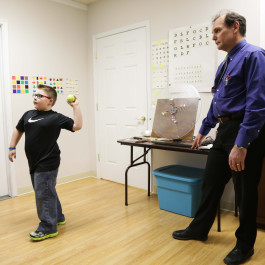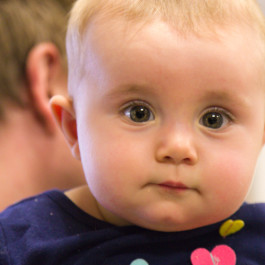Vision therapy services for the whole family.

Focus Difficulties
The human eye is an extremely finely tuned sensory organ. Although many of us take vision for granted, in those who have functional vision problems, simply seeing is not nearly so, well, simple. If you or your child or loved one has a focus difficulty that makes it hard for them to properly experience the visual world, it’s important you get that checked out right away. While most frequently these issues are addressed in childhood, it is also possible to treat older people as well.
With proper vision therapy and/or lenses, vision can substantially improve. Exercises that help the brain control the eyes more effectively can lead to markedly better vision, reducing blurriness and double vision, focusing better on small objects or text, and helping the eyes to work more effectively together.
This can have a range of benefits, especially if your child has been having learning difficulties in school. Unfortunately, eye fatigue from vision difficulties can make it hard for children to work effectively, while trouble with eye focusing can mean that children easily lose their spots or become confused while reading. If your child has been experiencing any of these problems, they likely need vision therapy and/or lenses to help them move past the problems and begin to improve their overall performance and success immediately.

Functional Vision Disorder
Your eyes, optic nerves, and visual cortex of the brain work together in an intricate way to allow you to see. But “seeing” is more than just looking at an image. Important visual functions that we rely on in our day-to-day-lives include things like eye teaming (binocular vision), fine eye movements (critical for reading), and visual accommodation (the ability to accurately and automatically focus on an object).
These and other visual tasks represent functional vision.
In other words, functional vision is the interplay between oculomotor (eye movement) and neurological influences on your ability to visualize, attend to, and interpret visual sensory information.
When it comes to a functional vision disorder, symptoms and severity can vary, but may include:
- Blurry Vision
- Eye strain and fatigue
- Headaches
- Double Vision
- Vision loss
A specific kind of functional vision problem is known as convergence insufficiency. This describes a condition in which a person’s eyes have trouble staying aligned and coordinated during reading and other activities that require fine sensory-motor control.
In children, what often appear to be behavioral problems – such as trouble paying attention in class and difficulty with reading and learning – may actually be related to a functional vision problem or some other disorder affecting the child’s eyesight. This is why it’s crucial to regularly bring your child in for a pediatric eye exam. It’s critical to ensure that your child’s vision is functioning appropriately and, if it is not, to implement an appropriate treatment plan as soon as possible so he or she can optimally participate in academics, athletics, and day-to-day-life.
Sports Vision
Good visual skills are required for maximum performance in all sports including Track and Field. This is where vision enhancement therapy steps in to assist the development of athletic improvement. Many therapy procedures intended for improved academic improvement can also have a positive effect on the playing field. A therapy plan for specific athletic goals can also be created. This is usually not thought of by most players and coaches, but can play an important aspect of successful sports performance.

Tracking Problems
## For some children developmental steps can be lost during growth missing out on various visual skills such as fine ocular motor movement. Some children never fall into efficient tracking skills which are vital for advancement in reading. If an individual cannot fixate and follow fluently then the flow of reading is not continuous and is broken-up, thus comprehension is also lost.
Tracking involves both pursuits and saccades done simultaneously. Saccades are directing your view from one point to another without losing your place such as on a page when reading. Pursuits are the ability to stay on a target as it moves or, in the case of reading, as your eyes scan across a line of words in a sentence.
It has been found that difficulties with the vestibular system (inner ear) such as chronic ear infections can have a negative effect on a child’s fine ocular motor development (tracking and saccades).##
Vision Workshop
The most common visual difficulties that children may have which affects performance at school are:
- Visual Stress
- Visual-Spatial Instability
- Fine Ocular Motor Dysfunction
First, some background about vision.
For eons, our vision developed to see far away. Hunting, gathering, spotting game and enemies; we did only brief periods of near work. A perfect match of far vision with what we needed to do to survive. But about 150 years ago, everything changed.
We began working at crafts, then in factories. About 100 years ago, compulsory education really began. Today worst of all, computers and cell phones everywhere; our vision was developed earlier for seeing distances, but now nearly everything we do requires prolonged, intense near vision work.
Learn More